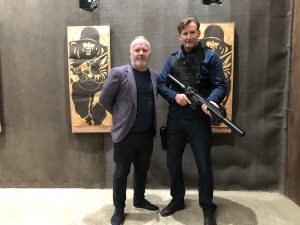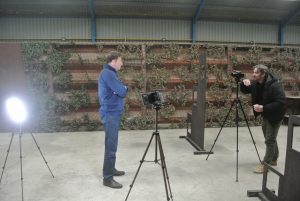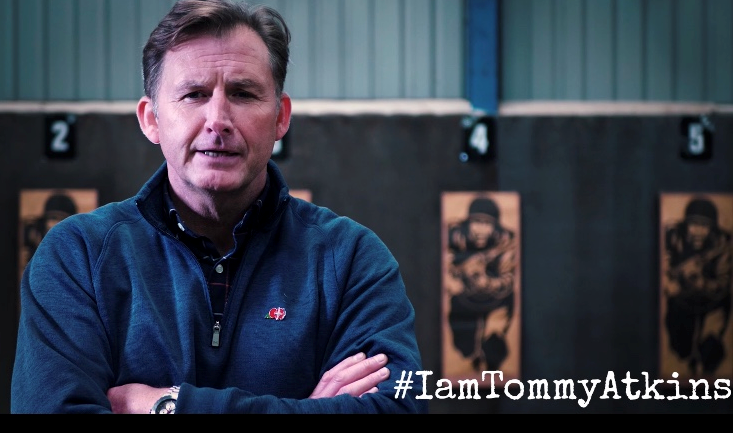As part of Pathfinder International’s on going “I am Tommy Atkins!” campaign to reflect and remember the fallen and past conflicts since World War 1 in this 100th year of the remembrance commemorations, we showcase one of the interviews from the November Remembrance special issue (click here to read for free).
The interview is with Sierra Leone hero and Military Cross recipient, Steve Heaney, with the first part talking about Steve’s deployment to Sierra Leone in 2000 as part of the Pathfinder task force. The interview will also be available online in the coming weeks.
For now, here is a taster of what is to come…
“I served for fifteen years with the Parachute Regiment from 1986 to 2001, ten of those years were with the Pathfinders. I joined junior Parachute company as a 16-year old, almost immediately after my last exam, I went in.
My light bulb moment on why I chose the Army kind of happened around about the Falklands conflict, so 1982, as a 13-year old at school, watching that on TV, the public adulation, the whole acceptance of us having to go and take back something that was taken from this country, it was that euphoria of seeing the ships laden with troops and the whole media coverage resonated so strongly with me.
My first operation was in Northern Ireland for Op Banner, in the January of 1989, we deployed to Belfast that was my first introduction into Operations and operational tempo.”
Following this, Steve joined the Pathfinders who as Steve puts it “did not officially exist” and not on the “order of battle”. He saw further operational action in Kosovo, before Sierra Leone took place in 2000, as Steve takes up the incredible story.
“The deployment of Op Palliser happened in May of 2000, nobody knew it was coming, I remember being at work, it was a Friday, it was the end of the week, the telephone rang and it was the Ops Officer from 1 Para, he phoned up and said “there’s been a situation in Sierra Leone”, I didn’t even know where it was, I couldn’t have pointed to it on a map, anyway “there’s been a situation and at the moment there’s orders to move 1 Para as a whole taskforce to Sierra Leone”.
The idea being that to rescue “entitled personnel” basically British passport holders, but any other nationality that was there under threat.
Sierra Leone at that point had been involved in a 10-year civil war, the government was on the verge of collapse, rebel organisations had sprung up to fill the vacuum created by the Sierra Leone army crumbling, the government crumbling, corruption and the like. So they had filled this void, they were now marauding across the country, raping, mutilating, trying to seize control of the country, the biggest of those belligerents of the gangs at the time was the Revolutionary United Front headed up by a former corporal in the Sierra Lone army.
His aim was to destabilise and take control of Sierra Leone and obviously take control of the diamond trade, which at that point was moving up from Sierra Leone into Liberia and was worth about $600 million a year.
The people of Sierra Leone were paying the price. Freetown (the capital) had a lot of British working there. It was perceived that this rebel organisation which was numbered at about 2,000 fighters, they’d already had engagements with the United Nations Aid Mission in Sierra Leone and a lot of skirmishes at the time, these gangs were making their way up from their strongholds towards Freetown.
These gangs as they made their way to Freetown were raping and pillaging villages and their signature of atrocity was amputation and you got a choice. They came into your village and you got the choice, long or short sleeve?
Long sleeve was they took your arm off below the elbow; short sleeve was they took your arms above the elbow and this was common practice.
It was brutality and evil on an industrial scale, with 70,000 people already been murdered.”

With Steve and the Pathfinder team having arrived at Lungi Airport, not far from the capital of Freetown, they were tasked with securing the airfield, assessing the situation in Freetown before being flown by Chinook to an outlying village near to known rebel locations.
“There was rebel movement anticipated towards the airfield in order to protect the airfield and give it the optimum chance of getting everyone out they said we are going to basically send the 27 strong Pathfinders team to stop them.
My subsequent conversations with David Richards in writing my book years later and his book, was that we were going to be exposed, the idea being that we were being a buffer and if we were to engage the rebels and inflict such a blow that it prevented them from moving onto the airfield then all good.
We got the brief, 27 of us, 2 Chinooks, 2 Pinzgauers and whatever ammunition we could find, which meant we were like kids in a sweetshop!
There was no room for bergens so it was your webbing and day sacks, it was light order. We had two days food, two days water, two days batteries and that was it.
The order was, you are going to fly in, 35kilometeres away, there will be no support, and you are on your own. They said we need you to hold your ground for 48 hours and we are going to send you to this village, which is the last main trading post that the Rebels would hit if they moved from their base, which was in the Port Loko area.
So our task was to hold that village, hold the track and stop them for 48 hours and we would be extracted.
And so we are on board 2 Chinook helicopters, 13 on one, 14 guys on another Chinook, it was about four o’clock in the afternoon, it was humid and I was soaked in sweat, one set of clothing and your day sack with the thought that we are going to get off the helicopter and we are going to be actively engaged in a gunfight. That was the sort of mind set we were getting the soldiers in.
If there was any reassurance in us going there, it was the fact there was a Platoon of QRF (Quick Reaction Force) should things go pear shaped there would be a Platoon’s worth of 1 Para on standby.
And so we flew in.
Now I had spent a lot of time in the jungle. I had been to Malaysia, I had spent a lot of time in Brunei, I had been to Central America, I had done work in Kenya, and I had spent a long time in the jungle.
I had jungle experience then in different types of jungle. Central America is very much sort of dirty jungle, it is secondary jungle it has been harvested and grown back, where as Borneo and Brunei, is very primary jungle, it has never been touched, so it’s like a forest it’s easier to move through, Kenya is similar, but I’d never seen anything like what we saw in Sierra Leone.
The jungle there was mangrove, we are now flying 100 knots at tree top level above the jungle with the ramp down and I have got the head sets on talking to the pilot and I am looking out of the back thinking there is nowhere to go.
We talked about an escape and evasion plan, what would happen if we got separated, if we ended up in a fight, where would the patrols RV? And I am looking out of the back and it’s just mangrove everywhere.
It was about 35-minute flying time and you can hear it on the headsets.
“Two minutes, thirty seconds, ramp down” and the troops are ready to go, waiting to see if the helicopter came under any fire and BOOM, smashed down, two Chinooks landed and where we landed was just north of the village, they’d had a little bit of vegetation cut back and so we are in effect amongst tree stumps.
So the Chinooks had smashed down, then we have two vehicles to drive off, we are all off the back and down into fire positions, waiting to come under contact.”
The second part of the incredible story of Steve Heaney and Sierra Leone can be found in the December issue of Pathfinder International, as our “I am Tommy Atkins!” campaign continues.

Interview with Mal Robinson.
![]()

